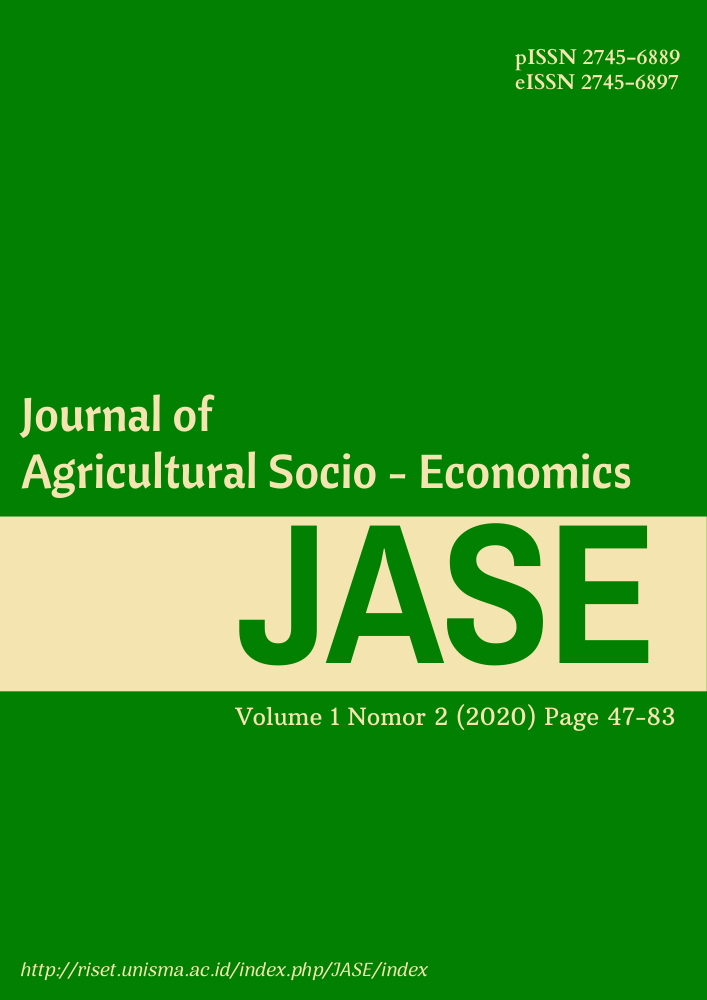Kinerja usahatani dan pemasaran terong ungu di Kabupaten Kupang, Nusa Tenggara Timur
DOI:
https://doi.org/10.33474/jase.v1i2.9094Keywords:
farming performance, R/C ratio, marketing margin, FS, marketing functionAbstract
Purple eggplant is becoming a popular plant cultivated, especially by small farmers in Kupang, East Nusa Tenggara (NTT). The purpose of this study was to measure the farm performance and marketing of purple eggplant. The research method used a survey method, using 46 sample farmers obtained by simple random sampling—the standard of eggplant cultivation measures farming performance. Business feasibility uses R/C ratio and marketing performance using Margin and Farmer Share (FS) and the marketing function. The results showed that the farming performance, as seen from the cultivation of purple eggplant, showed that every cultivation activity carried out by the farmer had almost fulfilled the ideal growth requirements according to the farmer's expectations with a production yield of 7.476 ton / 0.3ha. The income of purple eggplant farming is Rp. 3,033,840/the land area/planting season once. Purple eggplant farming is feasible, indicated by R/C> 1—marketing of purple eggplant through 4 marketing channels. The marketing system for eggplant is quite good, as indicated by the FS of 41.66%. Not many marketing functions are carried out at each stage so that not much-added value is generated. It is necessary to improve the purple eggplant cultivation system and increase the marketing function to increase the added value of purple eggplant.References
Belta, S. S., Sriyoto, S., dan M. Mustopa, R. (2018). Analisis Pendapatan Usahatani Sayur di Desa Pekalongan Kecamatan Ujan Mas Kabupaten Kepahiang Provinsi Bengkulu (Doctoral dissertation, Universitas Bengkulu). Undergraduated thesis, Universitas Bengkulu.
Dewi, I Made Tamba, MP. Putu Fajar Kartika Lestari, SP., M.Agb (2017). Kinerja Usahatani Padi Sawah (Kasus Subak Mambal, Kecamatan Abian Semal). Fakultas Pertanian. Universitas Mahasaraswati Denpasar. AGRIMETA. Vol 7. No.13. April 2017. ISSN: 2088-2521
Dewi, N., Yusri J., dan Saputra A. (2017) Analisis Struktur Perilaku dan Kinerja Pasar (Structure, Conduct And Market Performance) Komoditi Padi di Desa Bunga Raya Dan Desa Kemuning Muda Kecamatan Bunga Raya Kabupaten Siak. 2017. Jurnal Agribisnis Vol 19 No. 1 Juni 2017 ISSN P: 1412 – 4807 ISSN O: 2503-4375
Downey, W.D. dan Erickson, S.P. (1992). Manajemen Agribisnis. Erlangga. Jakarta.
Cenik, N. (2015). Analisis Usahatani dan Faktor-faktor Yang Mempengaruhi Pendapatan Petani Terung di Kecamatan Bulango Utara Kabupaten Bone Bolango. Skripsi, 1(614410014). UNG. Universitas Negeri Gorontalo.
Fadli, S. (2014). Analisis Pendapatan dan Kelayakan Usahatani Tomat di Kelurahan Boyaoge Kecamatan Tatanga Kota Palu. 2014. J. Agroland 21 (1) : 45 - 48, April 2014.
Intisari, I. (2017). Analisis Break Even Point Usahatani Terung di Desa Tulungsari Kecamatan Sukamaju Kabupaten Luwu Utara. Journal TABARO Agriculture Science, 1(1), 59-66.
Kusmawati, L. (2016). Analisis Saluran Pemasaran Cabai Merah Varietas Tanjung 2 (Suatu Kasus Di Kelurahan Tamanjaya Kecamatan Tamansari Kota Tasikmalaya). Jurnal Ilmiah Mahasiswa AGROINFO GALUH Volume 4 Nomor 1, September 2017.
Downloads
Published
How to Cite
Issue
Section
License
JASE: Journal of Agricultural Socio-Economics with a registration number of ISSN xxxx-xxxx (printed) and xxxx-xxxx(online) published by the Department of Agribusiness, Faculty of Agriculture at the University of Islam Malang by applying for copyright and License.
Copyright:
- Copyright in each text is the property of the author.
- The author agrees that JASE has the right to the first license issued with a Creative Commons Attributions-ShareAlike 4.0 International License.
- The author can write the article separately through non-exclusive distribution with other versions related to the article that was first published in the JASE : Journal of Agricultural Socio-Economics.
Licence:
- Attribution: You must give appropriate credit, provide a link to the license, and indicate if changes were made. You may do so in any reasonable manner, but not in any way that suggests the licensor endorses you or your use.
- ShareAlike: If you remix, transform, or build upon the material, you must distribute your contributions under the same license as the original.
- No additional restrictions: You may not apply legal terms or technological measures that legally restrict others from doing anything the license permits.
You are accessible to:
- Share a copy and redistribute this material in any form or format.
- Change and make derivatives of this material for any purpose, including commercial interests.
- The licensor cannot revoke the above conditions as long as the authors comply with the terms of this license.
Â

This work is licensed under a Creative Commons Attribution-ShareAlike 4.0 International License.








_-_Copy.jpg)

